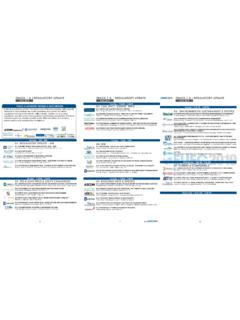Transcription of City of Atlanta – WIOA Plan 2016-2020
1 City of Atlanta WIOA plan 2016-2020 Page 1 of 108 City of Atlanta , Local Workforce Development Area 3 WIOA Local plan 2016- 2020 Table of Contents strategic Elements, Governance and Structure Local Boards and plan Development Service Delivery and Training Coordination with Core Partners State Initiatives and Vision ATTACHMENTS: 1 Local Workforce Development Board Member Listing 2 Local Negotiated Performance 3 Comments that Express Disagreement 4 Signature Page City of Atlanta WIOA plan 2016-2020 Page 2 of 108 strategic Elements, Governance and Structure 1. Identification of the Fiscal Agent Provide an identification of the entity responsible for the disbursal of grant funds described in WIOA 107(d)(12)(B)(i)(III) as determined by the chief elected official. City of Atlanta 55 Trinity Avenue. SW Atlanta , GA 30315 2. Description of strategic Planning Elements Provide a description of the strategic planning elements listed below.
2 A complete answer will rely on a variety of data sources and employer input. Also describe how the information was gathered and what partners and employers were consulted. a. Provide an analysis of the regional economic conditions including existing and emerging in-demand industry sectors and occupations; and the employment needs of employers in those industry sectors and occupations. Include the listing of occupations in demand within the region and describe how the list was developed citing source data. In 2015, the City of Atlanta is home to nearly 494,000 jobs. Health Care and Social Assistance is the largest industry in the city, accounting for over 63,000 jobs, or 13% of total employment. Professional, Scientific, and Technical Services (PST Services) is also a major employer, accounting for 11% of city jobs. Employment in this industry is also 80% more concentrated in the city than in the US overall. Employment in Public Administration (government services) is also highly concentrated in the in the city.
3 Average annual wages in City of Atlanta are high ($67,800), due in part to the size of the PST Services industry, which has an average annual wage of $98,000. City of Atlanta WIOA plan 2016-2020 Page 3 of 108 Industry Overview, 2 Digit NAICS City of Atlanta Industry Overview, 2 Digit NAICS - City of Atlanta 22 Utilities 3,277 1% $106,098 31 Manufacturing 13,791 3% $90,747 44 Retail Trade 32,905 7% $34,773 51 Information 24,021 5% $102,069 City of Atlanta WIOA plan 2016-2020 Page 4 of 108 Bold designates the largest industries by number of jobs in 2015 While employment in the City of Atlanta contracted during the recession, it has recovered steadily. Between 2010 and 2015, the city added over 45,000 jobs, increasing employment by 10%. The PST Services industries added the most jobs, increasing employment by over 10,500 jobs, or 23%.
4 Health Care and Social Assistance also grew rapidly, adding over 7,800 jobs. The Administrative and Support and Waste Management and Remediation Services industry also grew rapidly, adding over 7,500 jobs, expanding employment by 25%. This rapid growth in the temporary employment and staffing agencies industry suggests that some employers are using these services instead of hiring permanent employees directly. Over the same period, the Information, Wholesale Trade, and Educational Services lost jobs. Overall, employment growth in City of Atlanta between 2010 and 2015 outpaced growth in Georgia and the US. While employment in the city grew by 2% annually, employment in Georgia and the US grew by and , respectively. Over the next 5 years, employment in the City of Atlanta is expected to continue to grow, adding nearly 25,000 jobs, increasing employment by 5%. Growth is expected to be driven by the Health Care and Social Assistance industry, which is projected to add nearly 2,500 jobs.
5 The PST Services and Accommodation and Food Services industries are also expected to continue to grow rapidly. The Utilities and Manufacturing industries are expected to contract slightly. Annually, over 17,000 job openings are expected in City of Atlanta , due to both replacement demand and new demand. Over 70% of openings are expected to be created by replacement demand. The PST Services and Health Care and Social Assistance industries are expected to have the highest number of annual openings. Projected employment trends and annual employment demand are presented in the following table. Projected Change in Employment, 2 Digit NAICS - City of Atlanta 21 Mining, Quarrying, and Oil and Gas Extraction 1 6% 1 33% 67% 23 Construction 972 8% 437 45% 55% 42 Wholesale Trade 672 5% 469 29% 71% 55 Management of Companies and Enterprises 7,553 2% $117,127 61 Educational Services 32,862 7% $56,434 71 Arts, Entertainment, and Recreation 10,566 2% $43,054 81 Other Services (except Public Administration) 22,818 5% $33,837 NAICS Industry 5 Year Projection Employment Demand # Change % Change Avg.
6 Annual % New % Replacement 11 Agriculture, Forestry, Fishing and Hunting 2 2% 4 9% 91% 22 Utilities -107 -3% 82 0% 100% 31 Manufacturing -188 -1% 318 0% 100% 44 Retail Trade 1,028 3% 1,236 17% 83% 51 Information 467 2% 680 14% 86% City of Atlanta WIOA plan 2016-2020 Page 5 of 108 48 Transportation and Warehousing 358 1% 741 10% 90% 52 Finance and Insurance 1,545 5% 996 31% 69% 53 Real Estate and Rental and Leasing 619 4% 446 28% 72% 54 Professional, Scientific, and Technical Services 4,503 8% 2,111 43% 57% 55 Management of Companies and Enterprises 279 4% 218 26% 74% 56 Administrative and Support and Waste Management and 2,438 6% 1,353 36% 64% Remediation Services 61 Educational Services 1,922 6% 1,088 35% 65% 62 Health Care and Social Assistance 6,410 10% 2,548 50% 50% 71 Arts, Entertainment, and Recreation 533 5% 434 25% 75% 72 Accommodation and Food Services 1,984 4% 2,044 19% 81% 81 Other Services (except Public Administration) 955 4% 772 25% 75% 92 Public Administration 232 1% 1,134 4% 96% 99 Unclassified 101 5% 70 29% 71% Total - All Industries 24,827 5% 17,256 29% 71% Bold designates the industries with the highest average annual employment demand Red designates industries that are projected to lose the most jobs Green designates industries that are projected to add the most jobs Regional Perspective In 2017, the Metro Atlanta Region was home to nearly million jobs.
7 The largest industries in 2017 were Healthcare and Social Assistance, Retail Trade, and Professional, Scientific, and Technical Services. Combined, these three industries represent nearly one-third of all employment in the region. Overall, employment in the region has grown steadily over the past 10 years, adding over 140,000 jobs despite a dip in employment due to the nationwide recession. Employment growth has been even more dramatic if measured since 2010, as the recovery from the recession began. Over this 5-year period, the region added over 240,000 jobs, increasing employment by 12%, or an average annual rate of This rate of growth outpaces employment growth in the State of Georgia and the US, which have increased at an average annual rate of and , respectively. Employment in the region is expected to continue to grow, increasing by over 112,000 jobs, or 22,400 new jobs annually. In addition to new jobs, approximately 56,600 jobs are expected to need to be filled due to workers retiring or other turnover (Replacement Demand).
8 Replacement demand accounts for over 70% of total annual job demand. Combined, new and replacement demand are expected to account for nearly 80,000 job openings in the Metro Atlanta Region annually. Regional In-Demand Industries Regionally, the five Metro Atlanta Workforce Development Boards (City of Atlanta , Cobb County, DeKalb County, Fulton County, and the 7 counties included in the ARWDB) have identified three industries to target. These industries are: Healthcare Information Technology Transportation, Distribution and Logistics These industries were selected for a variety of reasons, including their size, past and projected growth, demand for workers, existing skill gaps, relevance to multiple counties City of Atlanta WIOA plan 2016-2020 Page 6 of 108 in the region, and the accessibility and quality of the jobs offered. While these industries were selected for the Metro Atlanta Region, each workforce board may also elect to select additional industries to focus on within its local area.
9 Healthcare Industry The Healthcare industry, which represents a range of industry sectors, including offices of physicians, hospitals, home health services, and nursing homes, accounts for 260,000 jobs in the Metro Atlanta Region. General and Medical Surgical Hospitals account for over a third of industry employment, representing nearly 70,000 jobs in 2017. Offices of Physicians (except Mental Health Specialists) is also a major sector, accounting for over 42,000 jobs in the 1 NAICS North American Industry Classification System Source: JobsEQ 2017Q4 City of Atlanta WIOA plan 2016-2020 Page 7 of 108 Employment in the Healthcare industry continued to grow during the recession, dramatically outpacing overall employment growth in the region over the same period.
10 It is anticipated that the industry will add 30,500 jobs, expanding employment by 17%. This growth was led by the General Medical and Surgical Hospitals and Offices of Physicians (Except Mental Health Specialists) sectors, which both added approximately 138,000 jobs. The Home Health Care Services grew rapidly over this period as well, expanding employment by 1,800 jobs. The Healthcare industry sectors that have added the most jobs over the past 5 years are summarized in the following table. Employment in the Healthcare industry is expected to continue to grow rapidly, expanding employment by 18%, or over 40,000 new jobs. Unlike many industries, new demand (jobs created from employment growth) account for more than half of these openings. General and Medical Surgical Hospitals and Offices of Physicians are projected to drive employment demand in the industry have the most employment demand over the coming years, with annual jobs openings of 4,000 jobs and 3,800 jobs, respectively.



